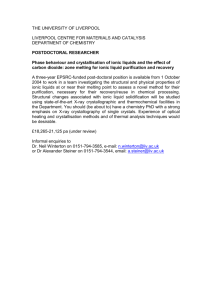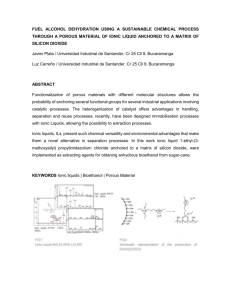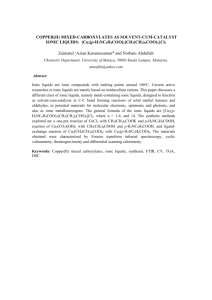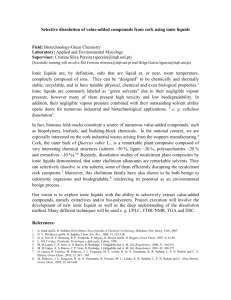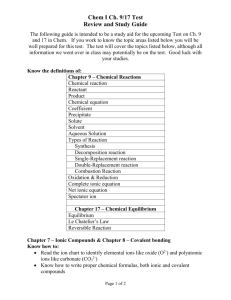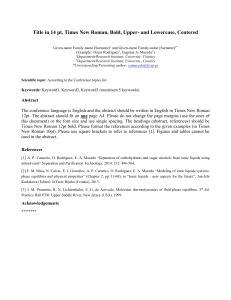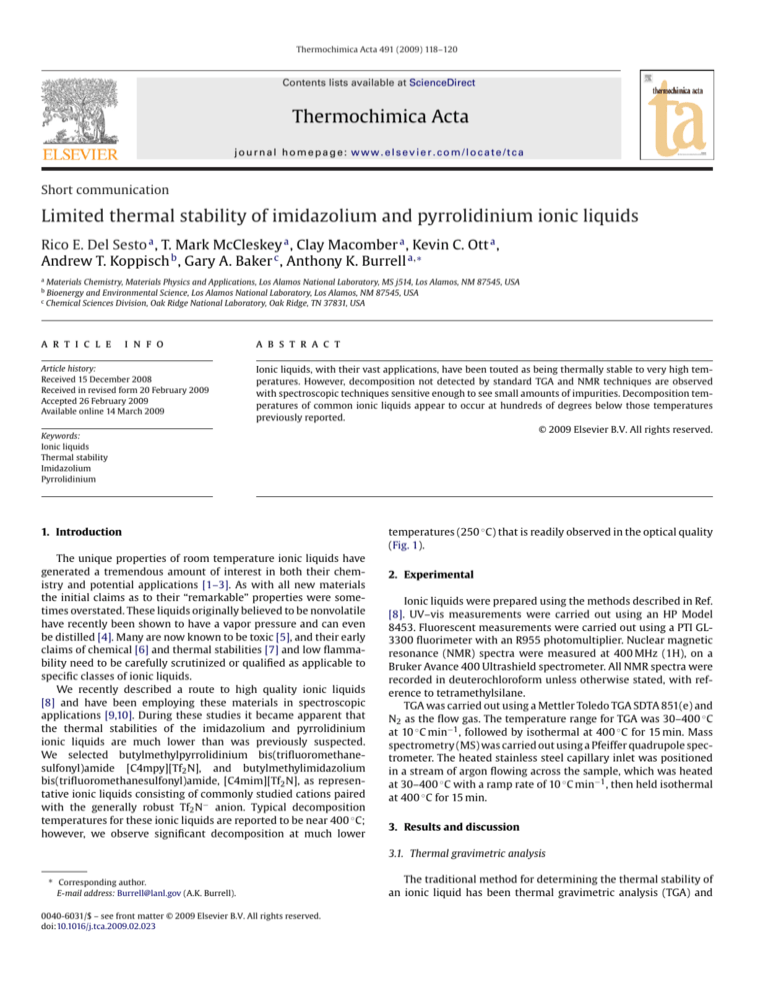
Thermochimica Acta 491 (2009) 118–120
Contents lists available at ScienceDirect
Thermochimica Acta
journal homepage: www.elsevier.com/locate/tca
Short communication
Limited thermal stability of imidazolium and pyrrolidinium ionic liquids
Rico E. Del Sesto a , T. Mark McCleskey a , Clay Macomber a , Kevin C. Ott a ,
Andrew T. Koppisch b , Gary A. Baker c , Anthony K. Burrell a,∗
a
Materials Chemistry, Materials Physics and Applications, Los Alamos National Laboratory, MS j514, Los Alamos, NM 87545, USA
Bioenergy and Environmental Science, Los Alamos National Laboratory, Los Alamos, NM 87545, USA
c
Chemical Sciences Division, Oak Ridge National Laboratory, Oak Ridge, TN 37831, USA
b
a r t i c l e
i n f o
Article history:
Received 15 December 2008
Received in revised form 20 February 2009
Accepted 26 February 2009
Available online 14 March 2009
Keywords:
Ionic liquids
Thermal stability
Imidazolium
Pyrrolidinium
a b s t r a c t
Ionic liquids, with their vast applications, have been touted as being thermally stable to very high temperatures. However, decomposition not detected by standard TGA and NMR techniques are observed
with spectroscopic techniques sensitive enough to see small amounts of impurities. Decomposition temperatures of common ionic liquids appear to occur at hundreds of degrees below those temperatures
previously reported.
© 2009 Elsevier B.V. All rights reserved.
1. Introduction
The unique properties of room temperature ionic liquids have
generated a tremendous amount of interest in both their chemistry and potential applications [1–3]. As with all new materials
the initial claims as to their “remarkable” properties were sometimes overstated. These liquids originally believed to be nonvolatile
have recently been shown to have a vapor pressure and can even
be distilled [4]. Many are now known to be toxic [5], and their early
claims of chemical [6] and thermal stabilities [7] and low flammability need to be carefully scrutinized or qualified as applicable to
specific classes of ionic liquids.
We recently described a route to high quality ionic liquids
[8] and have been employing these materials in spectroscopic
applications [9,10]. During these studies it became apparent that
the thermal stabilities of the imidazolium and pyrrolidinium
ionic liquids are much lower than was previously suspected.
We selected butylmethylpyrrolidinium bis(trifluoromethanesulfonyl)amide [C4mpy][Tf2 N], and butylmethylimidazolium
bis(trifluoromethanesulfonyl)amide, [C4mim][Tf2 N], as representative ionic liquids consisting of commonly studied cations paired
with the generally robust Tf2 N− anion. Typical decomposition
temperatures for these ionic liquids are reported to be near 400 ◦ C;
however, we observe significant decomposition at much lower
temperatures (250 ◦ C) that is readily observed in the optical quality
(Fig. 1).
2. Experimental
Ionic liquids were prepared using the methods described in Ref.
[8]. UV–vis measurements were carried out using an HP Model
8453. Fluorescent measurements were carried out using a PTI GL3300 fluorimeter with an R955 photomultiplier. Nuclear magnetic
resonance (NMR) spectra were measured at 400 MHz (1H), on a
Bruker Avance 400 Ultrashield spectrometer. All NMR spectra were
recorded in deuterochloroform unless otherwise stated, with reference to tetramethylsilane.
TGA was carried out using a Mettler Toledo TGA SDTA 851(e) and
N2 as the flow gas. The temperature range for TGA was 30–400 ◦ C
at 10 ◦ C min−1 , followed by isothermal at 400 ◦ C for 15 min. Mass
spectrometry (MS) was carried out using a Pfeiffer quadrupole spectrometer. The heated stainless steel capillary inlet was positioned
in a stream of argon flowing across the sample, which was heated
at 30–400 ◦ C with a ramp rate of 10 ◦ C min−1 , then held isothermal
at 400 ◦ C for 15 min.
3. Results and discussion
3.1. Thermal gravimetric analysis
∗ Corresponding author.
E-mail address: Burrell@lanl.gov (A.K. Burrell).
0040-6031/$ – see front matter © 2009 Elsevier B.V. All rights reserved.
doi:10.1016/j.tca.2009.02.023
The traditional method for determining the thermal stability of
an ionic liquid has been thermal gravimetric analysis (TGA) and
R.E. Del Sesto et al. / Thermochimica Acta 491 (2009) 118–120
119
Fig. 1. [C4mim][Tf2 N] with pure (left – before heating), and after heating at 250 ◦ C
for 12 h under dynamic vacuum (center) and under an atmosphere of N2 (right).
detection of decomposition products [11], as shown in Fig. 2a for
[C4mpy][Tf2 N]. The effluent gas was analyzed via mass spectrometry, and no appreciable volatile species are observed below 400 ◦ C
(Fig. 2b) at which point fragments are observed for Hoffmann elimination products from the pyrrolidinium ring of C3 H5 •+ (41 amu)
and C3 H6 N•+ (56 amu), C5 H11 N•+ (85 amu), and decomposition of
the anion though loss of CF3 •+ (69 amu).
Using TGA as the sole analytical technique it would appear that
there is no decomposition in [C4mpy][Tf2 N] until at least 400 ◦ C
based on the “onset” temperature of decomposition. It is important
to remember that TGA only measures weight loss, and since significant chemistry can occur before this the onset temperatures are
often inaccurate in describing thermal stability. Indeed MacFarlane
and co-workers [7], have redefined the decomposition temperature for [C4mpy][Tf2 N] using T0.01/10 , the temperature at which 1%
degradation – as determined by mass loss – occurs in 10 h. Using this
definition they determined the thermal stability of [C4mpy][Tf2 N]
to be as low as 271 ◦ C. Similar isothermal measurements have been
previously used to determine thermal stabilities, however TGA is
still standard [6,7].
3.2. UV–vis and fluorescence spectroscopy
We report here that some chemical changes occur at temperatures as low as 150 ◦ C. We have demonstrated that fluorescence
spectroscopy is a sensitive method for probing the decomposition
in imidazolium and pyrrolidinium ionic liquids. Changes in both fluorescence and visible absorption occur well before the formation of
volatile by-products observed in TGA measurements. Decomposition to yield colored and fluorescent impurities can have significant
implications for many practical applications of ionic liquids. With
Fig. 2. TGA (a) of [C4mpy][Tf2 N] and TGA-MS (b) with heating to 400 ◦ C at
10 ◦ C min−1 , followed by isothermal at 400 ◦ C for 15 min.
access to high purity ionic liquids it has been possible to probe
the changes that temperature induces in these materials. The background color and fluorescence due to impurities in good quality
ionic liquids is extremely low, and therefore impurities formed by
decomposition can be detected at much lower levels.
Heating the ionic liquids at temperatures above 150 ◦ C, even
under a dry inert nitrogen atmosphere, causes significant increase
in the color (Fig. 3) and concomitant changes in the UV–vis spectra, as seen in Fig. 3. No detectable mass loss is observed in either
heated sample.
We initially considered that these changes were primarily due
to the presence of small amounts of dissolved oxygen in the liquids. However, heating carefully degassed samples, under nitrogen
or dynamic vacuum still resulted in similar changes in the UV–vis
spectrum. The samples heated under dynamic vacuum do show
Fig. 3. UV/vis spectra for [C4mpy][Tf2 N] with heating for 12 h at 20, 50, 100, 150, 200, and 250 ◦ C under an atmosphere of N2 (left) and under dynamic vacuum (right).
Pathlength = 1 cm.
120
R.E. Del Sesto et al. / Thermochimica Acta 491 (2009) 118–120
Fig. 4. Fluorescence spectra for [C4mim][Tf2 N] after heating for 12 h at 20, 100, 150, 200, and 250 ◦ C under (left) an atmosphere of N2 , and (right) under dynamic vacuum,
and the distilled product. Excitation wavelength is 359 nm, emission wavelength is 440 nm.
significantly smaller changes in their absorptions, but the effect due
to decomposition is still observed. The changes in the UV–vis were
much more marked for the [C4mpy][Tf2 N] than the [C4mim][Tf2 N].
The changes observed in the fluorescence spectra upon heating
were much more pronounced than the absorption spectra, as seen
in Fig. 4. We observe growth in the fluorescence emission at temperatures over 150 ◦ C, Fig. 4, and significant increase in emission
at 250 ◦ C, again well below the temperatures necessary to generate
volatile by-products observed by TGA experiments.
NMR is a commonly utilized technique for determination of
purity of ionic liquids, but the sensitivity is not sufficient to determine impurities produced by decomposition at levels less than
about 1%. Distillation of the ionic liquid [C4mim][Tf2 N] yields a
deeply colored liquid, as evidenced by UV–vis with significant fluorescent impurities (Fig. 4, and in supporting information), but NMR
reveals no impurities.
The first observable indication of thermal degradation of the
ionic liquids appears as fluorescent decomposition products are
formed. The nature of these impurities will be difficult to determine as they do not appear to be sufficiently volatile for analysis
by GC–MS. In fact, they distill over with the ionic liquid itself. In
addition we have not been able to identify the impurities using electrospray mass spectrometry (ESI-MS). During these experiments,
only ion pairs belonging to the parent ions and their expected fragments are observed (similar to the TGA-MS experiments). Even at
very low ionization potentials, only parent ions and the higher associated ion pairs ([Cx Ax−1 ]+ , and [Cx Ax+1 ]− ) are observed. It is possible
that the impurities may be present in some form of oligomeric or
polymeric species.
4. Conclusions
While the pyrrolidinium and imidazolium ionic liquids do have
unique properties, their thermal stabilities are much lower than
previously thought. Chemistry which yields impurities begins at
temperatures above 150 ◦ C and is readily observed by an increase in
fluorescence, and colored impurities are formed well below the TGA
onset decomposition of 400 ◦ C. Oxygen is the most apparent culprit,
but it is advisable to consider that any chemistry performed in imidazolium and pyrrolidinium ionic liquids at temperatures above
150 ◦ C may be influenced by the degradation of the liquids themselves. Additionally, care must be taken in preparing and drying
ionic liquids such that high temperatures are avoided, as the heat
may encourage formation of fluorescent impurities, which must be
removed through extensive work up [8]. The desired purity of the
ionic liquids is, however, dependent on their application.
Acknowledgments
This work was supported by the DOE Buildings Technology Program. GAB acknowledges generous support by a Frederick Reines
Fellowship funded by Los Alamos National Laboratory.
Appendix A. Supplementary data
NMR of pure, heated, and distilled ionic liquids are available in
the supplementary data associated with this article which can be
found, in the online version, at doi:10.1016/j.tca.2009.02.023.
References
[1] R.D. Rogers, K.R. Seddon (Eds.), Ionic Liquids, Industrial Applications for Green
Chemistry, American Chemical Society, Washington, DC, 2002.
[2] T. Welton, Chem. Rev. 99 (1999) 2071–2083.
[3] B.M. Quinn, Z. Ding, R. Moulton, A.J. Bard, Langmuir 18 (2002) 1734–1742.
[4] M.J. Earle, J.M.S.S. Esperanca, M.A. Gilea, J.N. Canongia Lopes, L.P.N. Rebelo, J.W.
Magee, K.R. Seddon, R. Kenneth, J.A. Widegren, Nature 439 (2006) 831–834.
[5] C. Pretti, C. Chiappe, D. Pieraccini, M. Gregori, F. Abramo, G. Monni, L. Intorre,
Green Chem. 3 (2006) 238–240.
[6] M. Smiglak, W.M. Reichert, J.D. Holbrey, J.S. Wilkes, L. Sun, J.S. Thrasher,
K. Kirichenko, S. Singh, A.R. Katritzky, R.D. Rogers, Chem. Commun. (2006)
2554–2556.
[7] (a) T.J. Wooster, K.M. Johanson, K.J. Fraser, D.R. MacFarlane, J.L. Scott, Green
Chem. 8 (2006) 691–696;
(b) M. Smiglak, W.M. Reichert, J.D. Holbrey, J.S. Wilkes, L. Sun, J.S. Thrasher,
K. Kirichenko, S. Singh, A.R. Katritzkyc, R.D. Rogers, Chem. Commun. (2006)
2554–2556;
(c) D.M. Fox, W.H. Awad, J.W. Gilman, P.H. Maupin, H.C. De Long, P.C. Trulove,
Green Chem. 5 (2003) 724–727;
(d) M. Kosmulski, J. Gustafsson, J.B. Rosenholm, Thermochim. Acta 412 (2004)
47–53.
[8] A.K. Burrell, R.E. Del Sesto, S.N. Baker, T.M. McCleskey, G.A. Baker, Green Chem.
9 (2007) 449–454.
[9] R.E. Del Sesto, G.A. Baker, S.N. Baker, B.L. Scott, T.S. Keizer, A.K. Burrell, T.M.
McCleskey, Chem. Commun. (2006) 272–274.
[10] S.N. Baker, E.B. Brauns, T.M. McCleskey, A.K. Burrell, G.A. Baker, Chem. Commun.
(2006) 2851–2853.
[11] (a) J.L. Anderson, R. Ding, A. Ellern, D.A. Armstrong, J. Am. Chem. Soc. 17 (2005)
593–604;
(b) J.S. Wilkes, J. Mol. Catal. A 214 (2004) 11–17;
(c) P. Bonhote, A.-P. Dias, N. Papageorgiou, K. Kalyanasundaram, M. Gratzel,
Inorg. Chem. 35 (1996) 1168–1178;
(d) M.E. Van Valkenburg, R.L. Vaughn, M. Williams, J.S. Wilkes, Thermochim.
Acta 425 (2005) 181–188;
(e) J.M. Crosthwaite, M.J. Muldoon, J.K. Dixon, J.L. Anderson, J.F. Brennecke, J.
Chem. Thermodyn. 37 (2005) 559–568.


